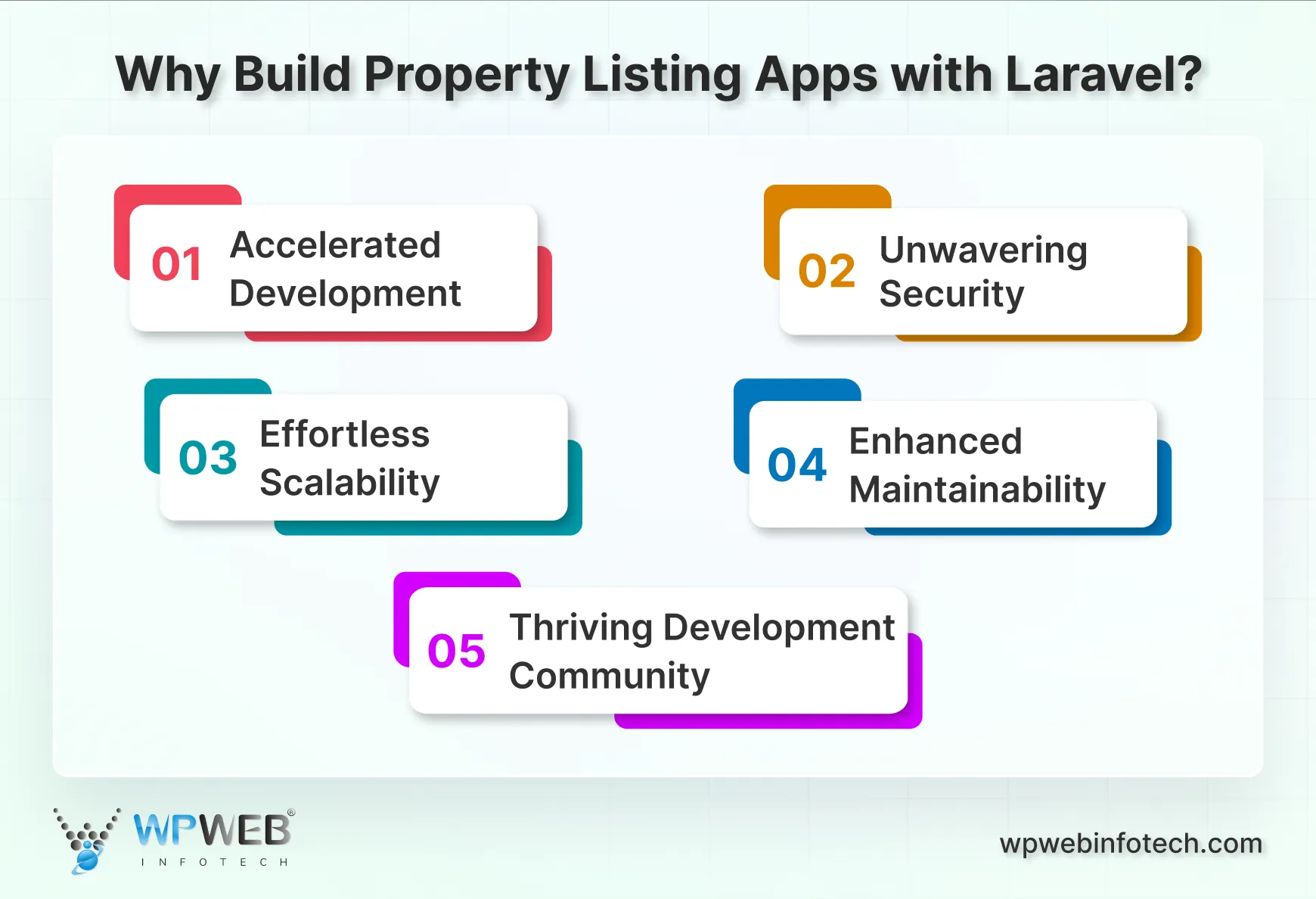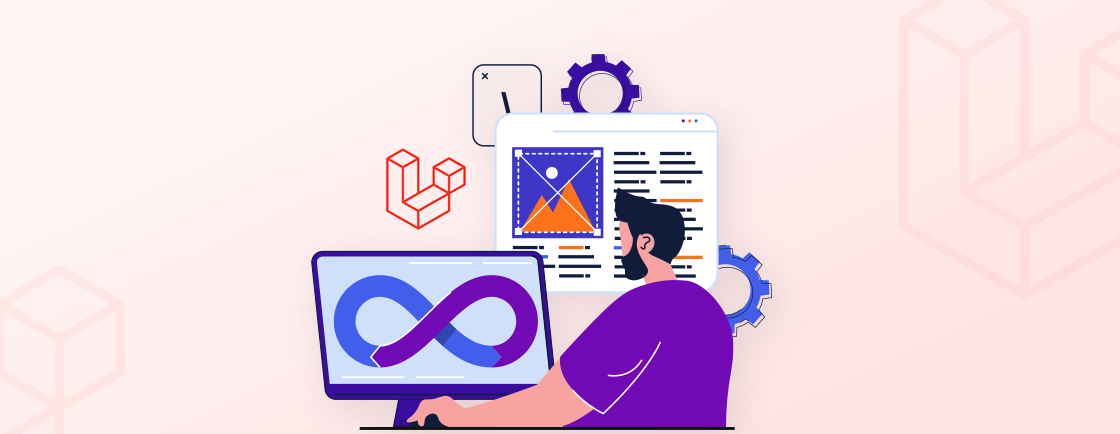Table of Contents
Property listing apps have become a cornerstone of the real estate industry. They offer the buyers and sellers a user-friendly platform for browsing and managing properties. To create the best platform, you need the best framework, and that’s where Laravel comes in.
Laravel can help construct a feature-rich and efficient property listing application. With Laravel, you can develop an intuitive UI, implement powerful search functionalities, and build a secure user management.
So in this blog, I’ll tell you all about why the experts use Laravel for property listing apps and how to do it effectively. Let’s first answer the “why”.
Why Build Property Listing Apps with Laravel?
As I said earlier, although there are several platforms, Laravel will be a suitable option for building a good property listing app. Here are a few reasons for it being a frontrunner.

Accelerated Development
Laravel, being one of the best PHP frameworks, provides a comprehensive toolkit brimming with pre-built functionalities. Features like Eloquent for streamlined database interactions and a well-defined routing system significantly expedite the development process.
And there are several Laravel packages like Cashier, Mix, Nova, etc. to ease the site or app development. Developers use these packages to craft unique features and functionalities. So your site stands out from the crowd. The Laravel eCommerce package helps to integrate advanced store management and checkout functionalities with minimal effort.
Unwavering Security
Security is paramount when dealing with user data, particularly in the realm of real estate. Laravel prioritizes security by incorporating a robust set of built-in features. They safeguard your application against prevalent threats such as SQL injections and cross-site scripting (XSS) attacks. This unwavering focus on security fosters a trustworthy platform that inspires user confidence.
Effortless Scalability
Property listing applications have the potential to attract a vast user base. Laravel’s architecture is specifically designed with scalability in mind. Laravel has a modular structure. The developers can use it to scale the application effortlessly. They can accommodate a growing user population without experiencing performance degradation.
Enhanced Maintainability
Laravel enforces a clean and well-organized codebase through features like namespaces and interfaces. This not only promotes code readability but also simplifies maintainability. This structured approach fosters efficient collaboration within development teams. It streamlines the future updates and feature additions. The same principles apply when developing enterprise applications with Laravel, where large-scale functionality and maintainable code are key priorities.
Thriving Development Community
The Laravel framework boasts a large and highly active developer community. This translates to a wealth of readily available online resources, tutorials, and forums. This supportive community empowers developers to find solutions and assistance throughout the development lifecycle. Many of these resources also helps developers in creating Laravel for eCommerce applications that handle large-scale transactions and secure payments efficiently.
These are just a few reasons to build the property listing app with Laravel. This framework can make the app or site feature rich and ensure security, scalability, and maintainability.
Of course, you can consult with an expert Laravel development company if you want to get the best out of this platform for your property listing app. Or follow through the next process to DIY.
How to Build Property Listing Apps with Laravel?
Laravel offers a bunch of tools and features to build web applications efficiently. But still, there is a step-by-step process involved in the development:
Step 1: Setting Up Laravel: Install Laravel using Composer, Laravel Installer, or via Composer create-project command. Set up your database connection in the .env file.
Step 2: Create Models, Migrations, and Controllers: Use artisan commands to generate models, migrations, and controllers for properties, users, and any other necessary entities. Define relationships between models if needed (e.g., a property belongs to a user).
Step 3: Database Design: Design your database schema considering the requirements of the property listing app. Typically, you’ll have tables for properties, users, and possibly additional tables for features, images, etc.
Step 4: Implement CRUD Operations: Implement Create, Read, Update, and Delete operations for properties. This involves creating routes, controllers, and views for managing property listings. Use Laravel’s resource controllers to handle CRUD operations efficiently.
Step 5: Authentication and Authorization: Implement user authentication and authorization using Laravel’s built-in authentication system or packages like Laravel Breeze, Laravel Jetstream, or Laravel Sanctum for API authentication. Restrict certain actions (like editing or deleting properties) to authenticated users.
Step 6: Building the UI: Design and develop the user interface for your property listing app using Blade templates, CSS frameworks like Bootstrap or Tailwind CSS, and JavaScript for interactivity. Create views for listing properties, viewing property details, and any other necessary pages.
Step 7: Implement Search and Filtering: Implement search functionality to allow users to search for properties based on criteria like location, price range, property type, etc. Implement filters to allow users to refine search results based on various attributes.
Step 8: File Uploads for Property Images: Implement file upload functionality to allow users to upload images of properties. Use Laravel’s built-in file storage capabilities or packages like Laravel’s Storage or intervention/image for image processing.
Step 9: Validation and Error Handling: Implement form validation to ensure that user input is valid before processing it. Handle errors gracefully and provide meaningful error messages to users.
Step 10: Testing and Deployment: Test your property listing app thoroughly to ensure that it functions as expected. Deploy your Laravel app to a web server using Laravel Forge or similar platforms.
The specific features and functionalities you incorporate will depend on your unique vision and target audience. But make sure you follow these steps properly and leverage the strengths of the framework to their best. For a deeper dive into managing customer data and workflows, know how developers build CRMs with Laravel using similar architectural principles.
To Conclude
A property listing app is a web application that helps users search and list properties for sale or rent. Laravel can be an excellent framework for building the backend and providing a robust and secure foundation for managing property listings.
Here’s how you create high-quality property listing apps with Laravel:
- Set Up Laravel
- Create Models, Migrations, and Controllers
- Database Design
- Implement CRUD Operations
- Authentication and Authorization
- Build the UI
- Implement Search and Filtering
- File Uploads for Property Images
- Validation and Error Handling
- Test and Deploy
For the best results with your property listing apps built on Laravel, hire Laravel developers with us today!
FAQs on Using Laravel for Property Listing Apps
Can I customize the design and features of my property listing app built with Laravel?
Yes, Laravel follows a modular approach, making it easy to add or remove features and customize the design according to your business needs. This flexibility allows for a unique and personalized property listing app for your brand.
Can I integrate third-party APIs into my Laravel property listing app?
Absolutely. Laravel has a built-in API integration feature that allows for seamless integration with third-party services. This can enhance the functionality of your property listing app and provide additional services for your users.
Can multiple users manage their property listings on the same app built with Laravel?
Yes, Laravel has excellent support for multi-user functionality, allowing for multiple users to manage their property listings on the same app. This can be beneficial for real estate agencies or property management companies.
Build Powerful Laravel Applications
Learn how to leverage Laravel's powerful features for efficient and scalable web development.





